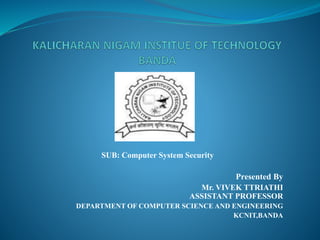
CSS (KNC-301) 2. TCP IP By Vivek Tripathi.pptx
- 1. SUB: Computer System Security Presented By Mr. VIVEK TTRIATHI ASSISTANT PROFESSOR DEPARTMENT OF COMPUTER SCIENCE AND ENGINEERING KCNIT,BANDA
- 3. What is TCP/IP Model? TCP/IP helps you to determine how a specific computer should be connected to the internet and how data should be transmitted between them. It helps you to create a virtual network when multiple computer networks are connected together. TCP/IP stands for Transmission Control Protocol/ Internet Protocol. It is specifically designed as a model to offer highly reliable and end-to-end byte stream over an unreliable internetwork.
- 4. TCP Characteristics Here, are the essential characteristics of TCP/IP protocol Support for a flexible architecture Adding more system to a network is easy. In TCP/IP, the network remains intact until the source, and destination machines were functioning properly. TCP is a connection-oriented protocol. TCP offers reliability and ensures that data which arrives out of sequence should put back into order. TCP allows you to implement flow control, so sender never overpowers a receiver with data.
- 5. Four Layers of TCP/IP
- 6. TCP/IP Conceptual Layers The functionality of the TCP/IP model is divided into four layers, and each includes specific protocols. TCP/IP is a layered server architecture system in which each layer is defined according to a specific function to perform. All these four layers work collaboratively to transmit the data from one layer to another.
- 7. Differences between the OSI and TCP/IP model:
- 8. Differences: OSI Model is developed by ISO (International Standard Organization). TCP/IP model is developed by ARPANET (Advanced Research Project Agency Network). OSI model provides a clear distinction between interfaces, between services, interfaces, and protocols. TCP/IP doesn't have any clear distinguishing points services, and protocols.
- 9. OSI refers to Open Systems Interconnection. TCP refers to Transmission Control Protocol. OSI uses the network layer to define routing standards and protocols. TCP/IP uses only the Internet layer. OSI follows a vertical approach. TCP/IP follows a horizontal approach. OSI is defined after the advent of the Internet. It is defined before the advent of the internet. In OSI The minimum size of the OSI header is 5 bytes. In TCP/IP Minimum header size is 20 bytes.
- 10. Most Common TCP/IP Protocols Some widely used most common TCP/IP protocol are: TCP: Transmission Control Protocol is an internet protocol suite which breaks up the message into TCP Segments and reassembling them at the receiving side.
- 11. IP: An Internet Protocol address that is also known as an IP address is a numerical label. It is assigned to each device that is connected to a computer network which uses the IP for communication. Its routing function allows internetworking and essentially establishes the Internet. Combination of IP with a TCP allows developing a virtual connection between a destination and a source.
- 12. HTTP: The Hypertext Transfer Protocol is a foundation of the World Wide Web. It is used for transferring web pages and other such resources from the HTTP server or web server to the web client or the HTTP client. Whenever you use a web browser like Google Chrome or Firefox, you are using a web client. It helps HTTP to transfer web pages that you request from the remote servers.
- 13. SMTP: SMTP stands for Simple mail transfer protocol. This protocol supports the e-mail is known as a simple mail transfer protocol. This protocol helps you to send the data to another e-mail address.
- 14. SNMP: SNMP stands for Simple Network Management Protocol. It is a framework which is used for managing the devices on the internet by using the TCP/IP protocol.
- 15. DNS: DNS stands for Domain Name System. An IP address that is used to identify the connection of a host to the internet uniquely. However, users prefer to use names instead of addresses for that DNS.
- 16. TELNET: TELNET stands for Terminal Network. It establishes the connection between the local and remote computer. It established connection in such a manner that you can simulate your local system at the remote system.
- 17. FTP: FTP stands for File Transfer Protocol. It is a mostly used standard protocol for transmitting the files from one machine to another.
- 18. Advantages of TCP/IP Here, are pros/benefits of using the TCP/IP model: It helps you to establish/set up a connection between different types of computers. It operates independently of the operating system. It supports many routing-protocols. It enables the internetworking between the organizations. TCP/IP model has a highly scalable client-server architecture. It can be operated independently. Supports a number of routing protocols. It can be used to establish a connection between two computers.
- 19. Disadvantages of TCP/IP Here, are few drawbacks of using the TCP/IP model: TCP/IP is a complicated model to set up and manage. The shallow/overhead of TCP/IP is higher-than IPX (Internetwork Packet Exchange). In this, model the transport layer does not guarantee delivery of packets. Replacing protocol in TCP/IP is not easy. It has no clear separation from its services, interfaces, and protocols.